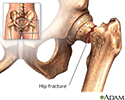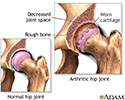Hip pain
Pain - hipHip pain involves any pain in or around the hip joint. You may not feel pain from your hip directly over the hip area. You may feel it in your groin or pain in your thigh or knee.
Causes
Hip pain may be caused by problems in the bones or cartilage of your hip, including:
-
Hip fractures -- can cause sudden and acute hip pain. These injuries can be serious and lead to major problems. It is more common in older patients because their bones can be weaker.
Hip fractures
Hip fracture surgery is done to repair a break in the upper part of the thigh bone. The thigh bone is called the femur. It is part of the hip joint...
Read Article Now Book Mark Article - Infection in the bones or joints.
Bones
Osteomyelitis is a bone infection. It is mainly caused by bacteria or other germs.
 ImageRead Article Now Book Mark Article
ImageRead Article Now Book Mark ArticleJoints
Septic arthritis is inflammation of a joint due to a bacterial or fungal infection. Septic arthritis that is due to the bacteria that cause gonorrhe...
 ImageRead Article Now Book Mark Article
ImageRead Article Now Book Mark Article - Osteonecrosis of the hip (necrosis from loss of blood supply to the bone).
-
Arthritis -- often felt in the front part of the thigh or groin.
Arthritis
Osteoarthritis (OA) is the most common joint disorder. It is due to aging and wear and tear on a joint.
 ImageRead Article Now Book Mark Article
ImageRead Article Now Book Mark Article - Labral tear of the hip.
- Femoral acetabular impingement -- abnormal growth around your hip that is a precursor to hip arthritis. It can cause pain with movement and exercise.
Pain in or around the hip may also be caused by problems such as:
- Bursitis -- pain when getting up from a chair, walking, climbing stairs, and driving
-
Hamstring strain
Hamstring
A strain is when a muscle becomes overstretched and tears. This painful injury is also called a "pulled muscle. "If you have strained your hamstring...
Read Article Now Book Mark Article -
Iliotibial band syndrome
Iliotibial band syndrome
The iliotibial band (ITB) is a tendon that runs along the outside of your leg. It connects from the top of your pelvic bone to just below your knee....
Read Article Now Book Mark Article -
Hip flexor strain
Hip flexor strain
The hip flexors are a group of muscles toward the front of the hip. They help you move or flex your leg and knee up toward your body. A hip flexor s...
Read Article Now Book Mark Article - Hip impingement syndrome
- Groin strain
- Snapping hip syndrome
Pain you feel in the hip may reflect a problem in your back, rather than in the hip itself. Pain due to problems in the hip joint itself is often felt most in the groin.
Home Care
Steps you can do to lessen hip pain include:
- Try to avoid activities that make pain worse.
- Take over-the-counter pain medicines, such as ibuprofen or acetaminophen.
- Sleep on the side of your body that does not have pain. Put a pillow between your legs.
- Lose weight if you are overweight. Ask your health care provider for help.
- Try not to stand for long periods of time. If you must stand, do so on a soft, cushioned surface. Stand with an equal amount of weight on each leg.
- Wear flat shoes that are cushioned and comfortable.
Things you can do to avoid hip pain related to overuse or physical activity include:
- Always warm up before exercising and cool down afterward. Stretch your quadriceps and hamstrings.
- Avoid running straight down hills. Walk down instead.
- For exercise, swim instead of running or biking.
- Run on a smooth, soft surface, such as a track. Avoid running on cement.
- If you have flat feet, try special shoe inserts and arch supports (orthotics).
- Make sure your running shoes are made well, fit well, and have good cushioning.
- Cut down the amount of exercise you do.
See your provider before exercising your hip if you think you may have arthritis or have injured your hip.
When to Contact a Medical Professional
Go to a hospital or get emergency help if:
- Your hip pain is acute and caused by a serious fall or other injury.
- Your leg is deformed, badly bruised, or bleeding.
- You are unable to move your hip or bear any weight on your leg.
Contact your provider if:
- Your hip is still painful after 1 week of home treatment.
- You also have a fever or rash.
Fever
Fever is the temporary increase in the body's temperature in response to a disease or illness. A child has a fever when the temperature is at or abov...
 ImageRead Article Now Book Mark Article
ImageRead Article Now Book Mark Article - You have sudden hip pain, plus sickle cell anemia or long-term steroid use.
Sickle cell anemia
Sickle cell disease is a disorder passed down through families. The red blood cells that are normally shaped like a disk take on a sickle or crescen...
 ImageRead Article Now Book Mark Article
ImageRead Article Now Book Mark Article - You have pain in both hips and other joints.
- You start limping and have difficulty with stairs and gait.
What to Expect at Your Office Visit
Your provider will perform a physical exam with careful attention to your hips, thighs, back, and the way you walk. To help diagnose the cause of the problem, your provider will ask questions about:
- Where you feel the pain
- When and how the pain started
- Things that make the pain worse
- What you have done to relieve the pain
- Your ability to walk and support weight
- Other medical problems you have
- Medicines you take
You may need x-rays of your hip or an MRI scan.
Your provider may tell you to take a higher dose of over-the-counter medicine. You may also need a prescription anti-inflammatory medicine.
References
Chen AW, Domb BG. Hip diagnosis and decision-making. In: Miller MD, Thompson SR, eds. DeLee, Drez, & Miller's Orthopaedic Sports Medicine. 5th ed. Philadelphia, PA: Elsevier; 2020:chap 77.
Guyton BJ. Hip pain in the young adult and hip preservation surgery. In: Azar FM, Beaty JH, eds. Campbell's Operative Orthopaedics. 14th ed. Philadelphia, PA: Elsevier; 2021:chap 6.
Huddleston JI, Goodman S. Hip and knee pain. In: Firestein GS, Budd RC, Gabriel SE, Koretzsky GA, McInnes IB, O'Dell JR, eds. Firestein and Kelly's Textbook of Rheumatology. 11th ed. Philadelphia, PA: Elsevier; 2021:chap 51.
-
Hip fracture - illustration
Hip fractures occur as a result of major or minor trauma. In elderly patients with bones weakened by osteoporosis, relatively little trauma, even walking, may result in a hip fracture.
Hip fracture
illustration
-
Arthritis in hip - illustration
Cartilage normally protects the joint, allowing for smooth movement. Cartilage also absorbs shock when pressure is placed on the joint, like when walking. Arthritis involves the breakdown of cartilage. Without the usual amount of cartilage, the bones of the joint rub together, causing pain, swelling and stiffness.
Arthritis in hip
illustration
-
Hip fracture - illustration
Hip fractures occur as a result of major or minor trauma. In elderly patients with bones weakened by osteoporosis, relatively little trauma, even walking, may result in a hip fracture.
Hip fracture
illustration
-
Arthritis in hip - illustration
Cartilage normally protects the joint, allowing for smooth movement. Cartilage also absorbs shock when pressure is placed on the joint, like when walking. Arthritis involves the breakdown of cartilage. Without the usual amount of cartilage, the bones of the joint rub together, causing pain, swelling and stiffness.
Arthritis in hip
illustration
Review Date: 4/24/2023
Reviewed By: C. Benjamin Ma, MD, Professor, Chief, Sports Medicine and Shoulder Service, UCSF Department of Orthopaedic Surgery, San Francisco, CA. Also reviewed by David C. Dugdale, MD, Medical Director, Brenda Conaway, Editorial Director, and the A.D.A.M. Editorial team.




